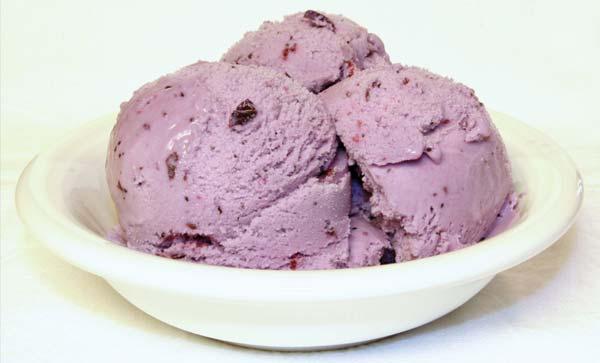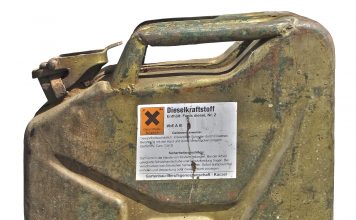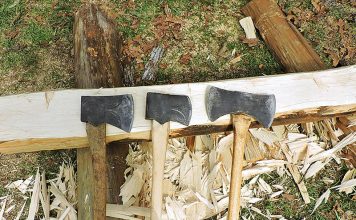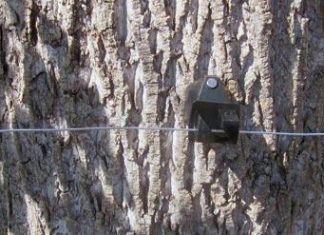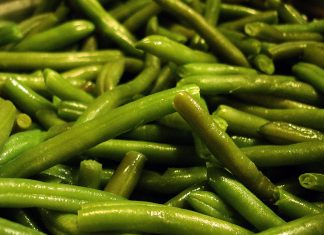| Issue #136 • July/August, 2012 |
A carpet of purple berries blankets the vibrant green bushes on the hillside in front of me. I’ve stumbled on a jackpot of purple gold: huckleberries. All I can think about are dozens of jars of huckleberry freezer jam, homemade huckleberry ice cream, and warm huckleberry coffee cake on a snowy, winter morning. But first I have to pick them, one berry at a time. I could pick for days if I had brought more buckets.
These are not berries you can find in the grocery store, only in the woods. They can be purchased at roadside stands for $25 to $35 per gallon! So as I fill each of my buckets, I take pride in knowing that I can fill a box in my freezer full of huckleberries for a fraction of that cost and enjoy them all year long. Huckleberries add a wonderful zest to baked goods, oatmeal, milkshakes, and ice cream. Huckleberry freezer jam atop warm, flaky biscuits tastes like the first berries of summer when served on a cold morning.
Wild huckleberries
Huckleberries cannot be found in the supermarket’s frozen section because they are not commercially produced. Researchers are trying to cultivate huckleberries for production on farms, but they have not been successful. Quietly, I cheer for Mother Nature does everything need to be commercialized?

Huckleberries ready to be picked
The huckleberries I’m referring to belong to the Heath family under the genus Vaccinium, which is the predominate huckleberry genus in the west. There are several varieties of huckleberries in the east and south that belong to genus Gaylussacia. A huckleberry is a huckleberry regardless of these Latin designations what we are after is the double pleasure of harvesting a delectable, healthy, wild crop and spending time outdoors, preferably with family and friends, two-footed and four.
Botanist or not, distinguishing a huckleberry from a blueberry is not as easy as purple and blue. Some huckleberries are blue or red while blueberries can be purple. Some botanists say the difference is in the seeds, with huckleberries having larger and fewer seeds than blueberries, but my huckleberry jam has an awful lot of tiny seeds.
Identification guides can help distinguish the two berries, but it doesn’t help when the common name includes both huckleberry and blueberry. However, the taste is different. Huckleberries have a distinct taste that is hard to describe, but I know that it tastes different than a blueberry. There are around 40 species of huckleberries worldwide with 12 species in Washington and Oregon.
My favorite huckleberry is also the most commonly harvested huckleberry in the west, Vaccinium membranaceum, which is more commonly referred to as the mountain huckleberry, globe huckleberry, black huckleberry, or Montana huckleberry. They are a sweet, blackish-purple berry that can be fairly good-sized if the conditions are right.
Finding huckleberries
Huckleberries begin to ripen anytime between July and September, depending on elevation. You’ll know when it is time to start looking for huckleberries when roadside stands start advertising fresh huckleberries. Huckleberry pickers work their way uphill as the season progresses. Lower elevations (around 3,500 feet) start ripening in July while higher elevations ripen in September. Huckleberries can be found anywhere between 2,000 to 11,000 feet in elevation.
Finding huckleberries requires knowing where to look. Western huckleberries range from Wyoming and Oregon north through Canada into southern Alaska. They prefer open areas with plentiful sunlight, such as logging units, avalanche chutes, old burns, forest clearings, or open lodgepole pine forests. There are exceptions, like the small patch of huckleberries by my barn, which is at 2,300 feet elevation with limited sunlight. I closely watch my little patch starting the first of July, knowing that when they are ripe it is time to head to my favorite patches in the woods. My patch doesn’t last long, since they are the first huckleberries of the summer and we sample them often and early just for the taste of fresh huckleberries.
While huckleberries grow in old burns, they aren’t like morels that proliferate the year after a fire. Huckleberries can take 15 years to reach maturity, but will bear fruit sooner. The ashy soil left behind by fires provides nutrients for the huckleberry plants, which thrive in damp, acidic soil.
Once you know what huckleberry brush looks like, it will be easier to find patches and see the ripe huckleberries. Drive around on logging roads or Forest Service roads and look for bushes with ripe berries alongside the roads, which may indicate more berries nearby. If vehicles are parked in random spots along the road, you probably have stumbled across someone’s favorite patch. Unspoken berry-picking etiquette is not to park and pick in the same spot, so drive down the road and find a similar looking spot to try.
Each year’s huckleberry crop depends on the weather. A cool, cloudy spring means a poor huckleberry year because the insects won’t have enough time to pollinate the short-lived blossoms. The Chinese Lantern-type flowers bloom between May and July and range in color from whitish-green to pinkish-red. In western species, most huckleberry plants produce a single berry from the leaf axil (where the leaf joins the main stem). The huckleberry crop in northern Idaho was poor last year at higher elevations because it was cool and rainy during flowering. Berry-picking was good at lower elevations, so I was glad I picked early in the season because otherwise I would have had to ration my huckleberries to last the winter.
When the berries finally ripen, they range in color from purple-black to bluish-black to reddish-black, depending on species. On the west coast of southern British Columbia the berries are usually translucent pale pink and can be used as trout bait in a pinch because they look so much like salmon eggs, according to outdoor writer Roger Brunt. This is a trick his father showed him more than 50 years ago and still works well today.
I find myself looking for new huckleberry patches whenever I am hiking in the mountains. I look for the flowers early in the summer and make a note to come back later when they might be ripe. Huckleberry brush turns red in the fall, making the plants easy to find and if you’re lucky the bears might have left a few. However, the berries will turn soft and start to ferment after a while or after a hard frost.
Harvesting and freezing
When picking, beware of other huckleberry-lovers, mainly bears. Huckleberries are a favorite food of both black and grizzly bears. They use their claws to rake huckleberries into their mouths. My husband once came across a bear sitting on its haunches in the middle of a huckleberry patch pulling branch after branch near its mouth and raking in the berries. After hearing this, I could believe that one bear could eat more than 30,000 huckleberries in a single day roughly 15 gallons! The berry-rich diet of bears is evident in the purple scat piles they leave behind. Deer, birds, rodents, and insects also eat huckleberries but not in the same quantity as bears. If your dog accompanies you huckleberry picking, be warned that he may become a “Huckleberry Hound” and eat the berries off the same bush from which you are picking.

The results of a few hours of picking
Metal and wooden berry-pickers are available to help pick berries faster, like bears do. Some people don’t like them because they take too many leaves off the bush and deposit them in their bucket. Commercial huckleberry-pickers use them in order to pick the most berries in the least amount of time.
During good years, when the huckleberries are big and plentiful, the picking is fast and buckets fill quickly. However, when the huckleberries are small, it can take several hours to fill a gallon bucket. I tend to use a small bucket to pick into and then frequently empty into ice cream buckets with lids stored in the truck (if nearby). This prevents me from spilling all of my berries if I trip over a log or over-enthusiastically swat at a mosquito. I’ve found that cutting the upper corner off a clean plastic milk jug works well for picking into, since the handle is sturdy.
After picking, you’ll have to sort out the leaves and debris in the bucket. If the berries are still firm but dusty, wash them in a colander and pick out the big debris. Otherwise, you don’t need to wash them if they are relatively clean. Gently transfer them onto a rimmed cookie sheet covered with a layer of paper towels (good quality paper towels help because you can wring them out between batches). Then pick out the remaining debris. Take another paper towel and place over the huckleberries and very gently roll the berries around on the sheet to dry them. You can use a lightweight kitchen towel, but use an old one because huckleberries leave purple stains.
Some of the huckleberries will still have stems attached. It is a personal preference whether or not you want to remove them. I find that a few stray stems don’t seem to make a difference in baked goods.
To freeze for later use, place the huckleberries in a single layer on cookie sheets in the freezer. After a few hours or overnight, use a pancake spatula to loosen the frozen berries from the cookie sheet and place them in freezer bags. This method makes it easy to take out a cupful of berries instead of a frozen mass of berries.
Health benefits
Huckleberries are nutrient-packed. Just as blueberries are known for their antioxidant powers, huckleberries are too. One cup of huckleberries contains 81 calories and is packed with antioxidants and anthocyanins. They are high in vitamin C, vitamin B, and iron.
Huckleberries have been found to improve vision, strengthen capillaries and stimulate blood circulation. This leads to protection against heart disease, macular degeneration, and glaucoma. They have been used to treat diarrhea, hemorrhoids, and sugar metabolism problems. Huckleberries have been said to help aid the pancreas in digesting sugars and starches.
Recipes
In addition to the health benefits, huckleberries taste good, whether straight from the bucket or in baked goods. One of my favorite ways to eat huckleberries is to sprinkle them on pancakes after I have poured the batter on the skillet (this prevents purple pancakes) and I top the pancakes with granulated sugar instead of syrup.
Each huckleberry picker has their favorite recipe or way to use the first batch of huckleberries. Many eat them straight from the bucket, put them on cereal, bake a pie, or whip up a huckleberry milkshake. Here are a few of my favorite huckleberry recipes.

Homemade huckleberry ice cream
Huckleberry ice cream
This recipe is easy since the vanilla ice cream utilizes ingredients commonly found in the refrigerator and pantry. Since the recipe requires the custard to chill, I make both the custard and compote in the morning and then refrigerate them until evening, when I put the mixture in my ice cream maker.
2 cups milk (2% or skim)
2 large eggs
14 ounce can sweetened condensed milk (regular or fat-free)
4 tsp. vanilla extract
Bring milk to a simmer in a medium saucepan. Meanwhile, beat eggs in a mixing bowl. Slowly add warm milk to egg mixture while beating. Pour mixture back into saucepan and place over medium-low heat. Stir constantly with a wooden spoon until mixture thickens to a custard or white sauce consistency. Do not let it boil or the eggs will scramble. Pour the mixture through a strainer into a clean bowl. (I usually have cooked pieces of egg whites left in the strainer. If the egg whites are still clear, the mixture needs to be cooked longer). Let the mixture cool slightly, then add the sweetened condensed milk and vanilla. Cover and refrigerate until cold, usually several hours. Mix in huckleberry compote and follow ice cream maker’s instructions. Makes 1 to 2 quarts.
Huckleberry compote
11/2 cups huckleberries
3 Tbsp. sugar
6 Tbsp. water
1/2 tsp. lemon juice (optional)
Combine huckleberries, sugar, and water in small saucepan and cook over medium heat for 10 minutes. Stir occasionally to break up berries or smash them if frozen. Remove from heat and stir in lemon juice. Cover and refrigerate until ready to mix with chilled custard.
Huckleberry coffee cake
If I’m short on time, I will pour the coffee-cake batter into muffin tins and bake until a toothpick comes out clean.
11/2 cups flour
1/4 cup sugar
21/2 tsp. baking powder
1/4 cup shortening
3/4 cup milk
1 egg
1 cup huckleberries
Topping: (Make half the topping if you prefer it less sweet or if making muffins.)
1/2 cup sugar
1/3 cup flour
1/2 tsp. cinnamon
1/4 cup soft butter
Combine topping ingredients until crumbly, set aside. Combine remaining dry ingredients. Cut in shortening, then add milk and egg. Beat 50 quick strokes with a fork. Stir in huckleberries. Pour into a greased 9-inch square pan. Sprinkle topping on batter. Bake at 375° F for 25-30 minutes or until toothpick comes out clean.
Huckleberry cheese pie
1 graham cracker crust
8 ounces cream cheese, softened
2 eggs
1/2 cup sugar
1/4 tsp. salt
1 tsp. vanilla extract
Topping:
½ cup sugar
2 Tbsp. cornstarch
½ cup water
2 cups fresh or frozen huckleberries
Blend cream cheese, eggs, sugar, salt, and vanilla. Beat until smooth. Pour into graham cracker crust. Bake at 325° F for 25-30 minutes until filling is set. Cool.
To make topping, mix sugar and cornstarch in saucepan. Stir in water and huckleberries. Boil over medium heat, stirring until clear and thickened. Remove from heat and cool to room temperature. Spread topping on pie. Refrigerate pie several hours before serving.

Huckleberry buckle
Huckleberry buckle
21/2 cups huckleberries (fresh or frozen)
1/3 to 3/4 cup sugar
1/2 cup sugar
1/4 cup butter
1 cup flour
1 tsp. baking powder
1/4 tsp. salt
1/2 cup milk
1/2 cup boiling water
1 Tbsp. butter
Sprinkle 1/3 cup to ¾ cup of sugar on huckleberries, depending on the sweetness of the berries. Stir gently and let stand.
Cream ½ cup sugar and ¼ cup butter. Add dry ingredients to creamed mixture with milk. Spread mixture in an 8-inch greased pan. Pour berries over batter. Dot with butter and pour hot water over all. Bake at 350° F for 45-50 minutes. Serve with whipped topping or vanilla ice cream, if desired.
I have substituted huckleberries in recipes calling for blueberries with good results, including canned jams, freezer jams, and syrups. Trying new combinations is sometimes surprisingly rewarding, like huckleberry syrup over pumpkin cheesecake. With all the health benefits of huckleberries, they are purple gold in more ways than one.


